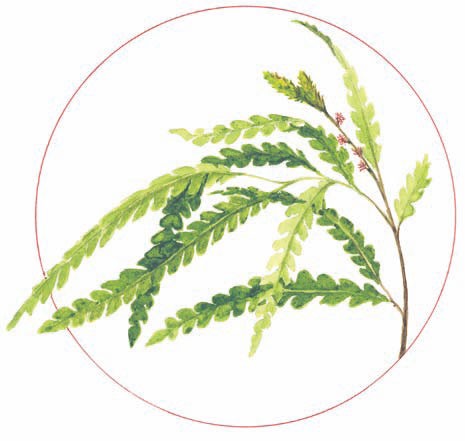
Plants in the wax-myrtle family – notably bayberry and sweet gale – are known for their fragrance. But sweetfern may be the most aromatic of all. On hot, sunny days, the scent is detectable from a considerable distance, and the wonderful aroma from a handful of crushed leaves can be almost overwhelming. In winter, with a little imagination, you can bring back memories of summer days by crushing and smelling the browned leaves that often persist on the shrub.
And shrub it truly is: sweetfern rarely grows more than a meter high. It branches freely, arises from underground stems, and will create a dense thicket in conditions to its liking, which include dry, rocky, barren habitats with acidic soil. Powerline rights-of-way, road cuts, the edges of sand pits, and rocky outcrops in full sun often have sweetfern, but you’ll not commonly find it in richer environments, where it is easily outcompeted by other plants.
Sweetfern flourishes in these marginal places because it has teamed up with bacteria that turn atmospheric nitrogen into a form that the plant can use. Though nitrogen accounts for about 80 percent of the Earth’s atmosphere, it is in a stable form and, however abundant, is useless to plants. The dinitrogen molecule must be split and combined with hydrogen to form ammonium, a process that requires considerable energy. No higher plants can do this: only bacteria, lightning, and fertilizer factories.
Most of us are familiar with legumes that use Rhizobium bacteria to create usable nitrogen, but over 160 species of nonleguminous plants have made deals with another group of bacteria: the filamentous actinomycetes in the genus Frankia. It is a classic symbiotic relationship in which the plants provide the bacteria with sugars and minerals in exchange for usable nitrogen.
Worldwide, the bacteria in nonlegumes, such as sweetfern, fix as much nitrogen as the much more famous leguminous ones, and more pounds of nitrogen per acre as well, but while Rhizobium was isolated and cultured from legumes in 1888, Frankia was not successfully grown outside its traditional hosts until 1978, despite great effort. Sweetfern was the source of the first Frankia bacteria to be isolated and grown independently. The perennial nodules within which this transformation occurs can easily be seen if you dig up a sweetfern and look at the bumps on its roots.
During reforestation projects on poor soils, alders and other actinorhizal plants (as these nonleguminous nitrogen fixers are called) are being interplanted experimentally with forest trees to give the trees access to the bacteria-created nitrogen that leaks into the surrounding soil or becomes available as the plant’s foliage falls and decays. Perhaps because it is difficult to propagate, sweetfern has not been used in this way, but it is out there on its own, enriching impoverished soils and playing a role in forest succession.
The leaves of sweetfern do superficially resemble the pinnules of a fern, being slender and indented almost to the midrib. Many herbaceous plants have fern-like foliage, but sweetfern is the only woody plant in the Northeast with this pattern. Along with its spicy scent and habitat limitations, the foliage makes sweetfern very easy to identify.
The male and female flowers are usually, but not always, on separate plants. In April, before the leaves open, copious amounts of pollen are released from the male catkins and are carried by the wind to the small, unremarkable female flowers. By September, small, edible nutlets have ripened inside of burrlike scales. These seeds can be stubbornly dormant and can remain viable for up to 70 years. Most buried seeds will germinate only after being exposed to strong temperature fluctuations – the kind of changes that indicate shade has been removed and that full sun is once again available.
Sweetfern is hardy to Zone 2 and unhappy in anything warmer than Zone 6. It grows throughout the Northeast, following the mountains southward. It shares both habitat and a disease – sweetfern blister rust – with jack pine and other two- and three-needled pines. This disease is not harmful to sweetfern but does sometimes injure and kill the pines. Sweetfern can be a troublesome weed in cultivated fields of lowbush blueberry.
Although sweetfern is not known for its value to wildlife, grouse feed on its buds and catkins, flickers eat the fruits, and white-tailed deer browse the foliage.
Sweetfern is an excellent choice for the more barren or acidic areas of a garden – those spots where nothing else seems to do well. It will thrive in acidic soils, forms a nice dense thicket, and stays within reasonable size limits, so no pruning is needed. And best of all, you won’t have to hike to a high, dry hilltop to experience sweetfern’s wonderful fragrance.


Discussion *